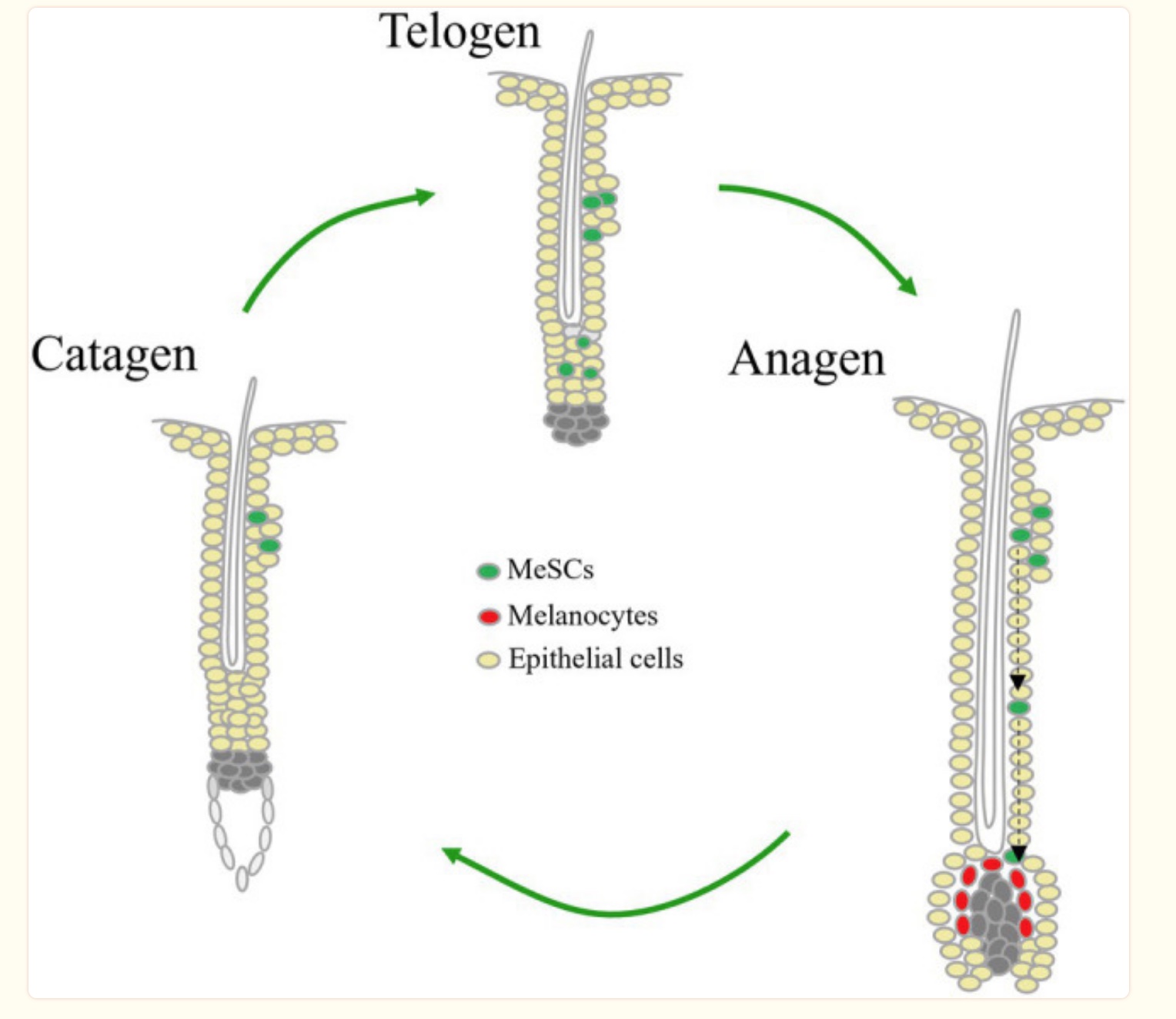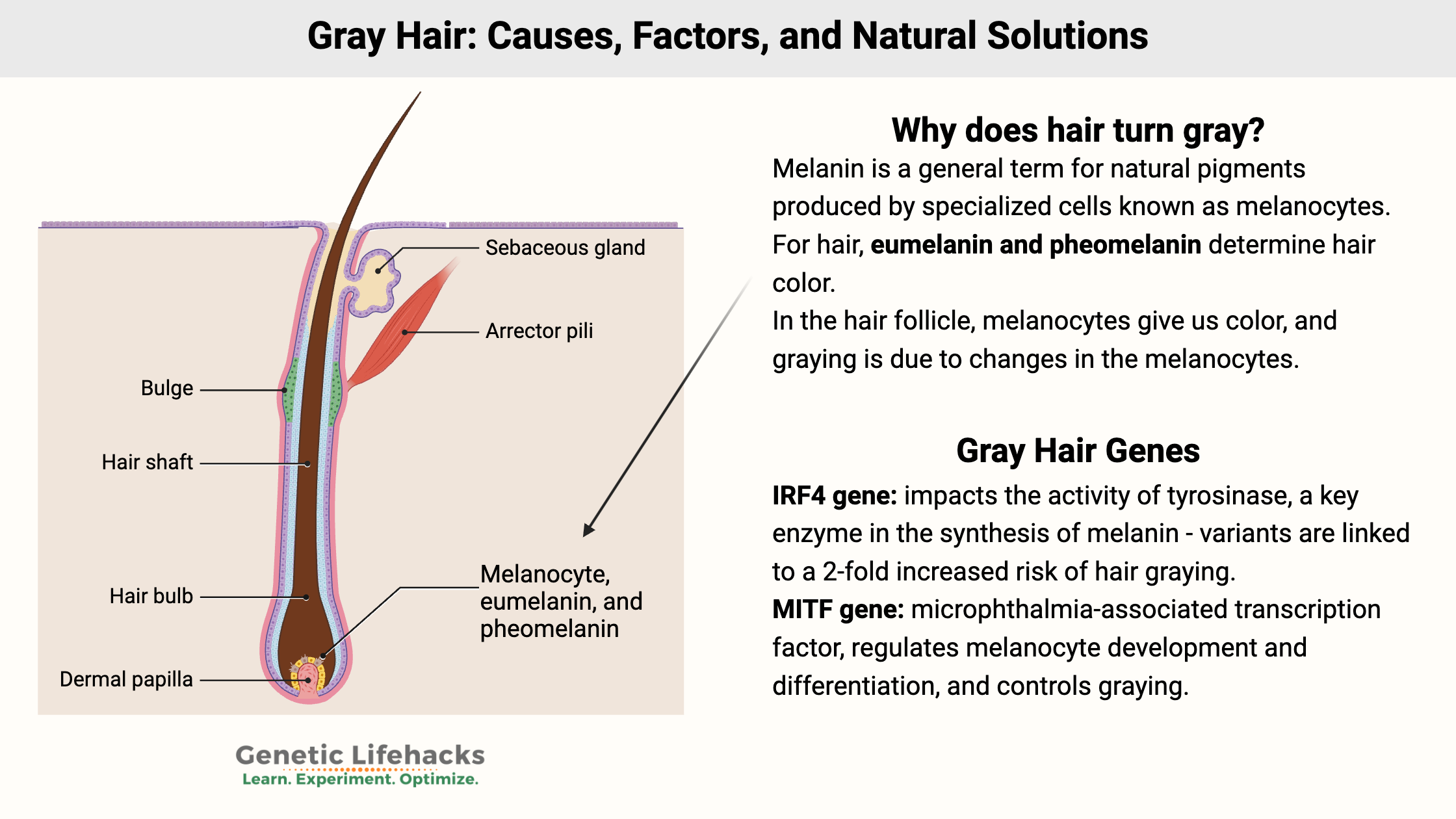Key takeaways:
~ Gray hair is likely due to a lack of melanocytes (melanin-producing cells) in the hair follicle.
~ Melanocyte stem cell dysfunction may be to blame.
~ Genetics plays a role in whether you are likely to go gray earlier or later.
Why does hair turn gray?
Gray hair is something that we just accept as a natural part of aging. But why does it happen? And what can you do about it?
About half of people have nearly half of their hair turn grey by the age of 50 (the 50-50-50 rule), according to research. For people of European ancestry, graying starts around age 35, with graying starting later in people of Asian and African ancestry. Graying that starts before age 30 is termed premature hair graying.[ref]
Background on hair color:
Melanin is a general term for natural pigments produced by specialized cells known as melanocytes. These pigments give us hair color, skin color, eye color, and for other animals – feather colors, scale colors, etc.
For hair, eumelanin and pheomelanin determine hair color. In the skin, eumelanin acts to absorb and dissipate UV radiation, protecting the skin from radiation damage. Skin turns darker with sun exposure, reacting to produce more melanin to prevent further UV damage.
Eumelanin is derived from tyrosine or DOPA (3,4-dihydroxyphenylalanine) that is oxidized into dopaquinone. Pheomelanin is formed from the addition of cysteine to dopaquinone during pigment biosynthesis.[ref]
Dark hair (black and brown) is due to higher eumelanin content, and reddish or orangish tones are due to pheomelanin. Blonde hair is due to having less eumelanin.
Going gray:
In the hair follicle, melanocytes give us color, and graying is due to changes in the melanocytes.

There is quite a bit of research on hair follicles… (Think of the money you could make from a drug that reverses gray hair or balding). However, researchers don’t have all the answers yet.
In the early 2000s, there was a lot of focus on mitochondrial function in melanocytes. There were also a lot of popular health articles claiming that high levels of hydrogen peroxide (perhaps due to poor mitochondrial function) cause gray hair. Researchers can cause hair to go gray in animals by treating it with radiation or hydrogen peroxide.[ref]
More recently, though, the role of melanocyte stem cells has been investigated. DNA damage to melanocyte stem cells causes depletion. The depleted stem cells then result in an absence of melanocytes in the hair bulge.[ref]
Let’s dig into the role of melanocyte stem cells a little more:
Hair follicles cycle between phases:
- growth – anagen phase
- degeneration -catagen phase
- rest – telogen phase
Melanocyte stem cells in the anagen phase migrate to the hair bulb and form differentiated melanocytes, which produce hair color. During the catagen phase, the mature melanocytes are destroyed, and thus new melanocytes will be derived from the stem cells for future hair growth cycles.[ref]
About 90% of scalp hairs are in the growth or anagen phase. Hair grows about half a millimeter a day, making these epithelial cells very proliferative.[ref]
Gray or white hair is usually growing more rapidly than darker hair. This is also true of eyebrow hair, where the long eyebrow hairs are white, and the shorter ones are dark.[ref]
Thus, while gray hair lacks melanocytes to produce melanin, the hairs grow well and are not damaged.

Psychological or physical stress causes accelerated graying?
In a mouse model, researchers have shown that stress can cause gray hair.
When you are stressed (physical or psychological), the body releases cortisol and norepinephrine (noradrenaline).
In the animal study, the researchers injected a capsaicin-like substance that triggered the pain sensor and caused a stress response. The researchers did this specifically in the hair follicles and found that it caused a loss of melanocyte stem cells within five days. When the hair follicles then entered the catagen phase, the active melanocytes were destroyed (as is normal), but new melanocytes couldn’t be made due to the lack of stem cells.[ref]
The researchers went further with determining what was altering the melanocyte stem cells. They found that it was not due to immune system involvement (not T cells or B cells). Instead, they discovered that the melanocyte stem cells express both the receptor for cortisol (GR) and receptors for norepinephrine (β2 adrenergic receptor, ADRB2).
The researchers next determined that it wasn’t the cortisol receptor by knocking out the GR receptor in the mice. Instead, the ARDB2 receptor seems to be the key, and the release of norepinephrine in extreme stress is causing gray hair through depleting hair follicle stem cells. In fact, injecting norepinephrine into the skin by the hair follicle also could cause hair graying.
Extreme stress events have been linked to sudden graying of hair. But this doesn’t mean that you will get more gray hairs every time you’re stressed about something. A study of medical students tested the idea of exam stress causing changes to hair follicles. The results showed that even under stress, the hair parameters stayed within a physiological range.[ref]
What about mitochondrial stress?
A recent study put hairs from 14 people under an electron microscope for analysis. The images confirmed that white hairs had very little melanin in them (about 98% of the melanin was gone).[ref]
The researchers also did proteomics testing on the hairs to see how protein expression differed between gray and pigmented hair. They found that 27% of the upregulated protein in gray hair is related to mitochondrial function and energy metabolism. The gray hairs also had increased protein involved in glucose metabolism and lipid metabolism.
The researchers also found a second pattern of downregulated proteins related to the melanosomes that store the melanin pigments.
Finally, the proteomics tests showed that gray hairs had upregulated SOD1 and PRDX2, which are antioxidant proteins.
Altogether, this could point to oxidative stress in the mitochondria, causing a decrease in melanosomes.[ref]
MITF and hair graying:
The MITF (melanogenesis-associated transcription factor) protein may be at the heart of normal hair graying. MITF is a transcription factor, turning on the genes needed for the melanocyte precursors to migrate to the right place in the hair follicle. MITF also turns on and off pigmentation genes that synthesize melanin.[ref]
Loss of MITF in mice causes the babies to be born with white fur. This is different than albinoism.[ref]
The MITF protein is transcriptionally regulated by SOX10, which is a transcription factor active during embryo formation. It turns on and off the genes needed for developing the neural crest and spinal cord.[ref]
A recent animal study showed that MITF does more than regulate melanocytes. It also is involved in repressing type I innate immune response in certain cell types.
This isn’t entirely unexpected. Vitiligo, an autoimmune disease, also ties into innate immune response and melanocyte changes. In vitiligo, patches of hair can become gray, and skin can become unpigmented. Innate immune genes are linked to vitiligo, and case reports show that hepatitis C patients receiving interferon-alpha are susceptible to vitiligo.[ref]
MITF and Tyrosine-related genes:
The strongest genetic factor for increased hair graying is in the IRF4 gene. IRF4 (interferon regulatory factor) interacts with the MITF transcription factor, and MITF activates tyrosinase, an enzyme needed for melanin synthesis. Tyrosinase converts the amino acid tyrosine, which is important in melanin pigment.[ref] The variant in IRF4 is thought to influence how MITF impacts melanocyte stem cell survival and migration.[ref]
Environmental and nutritional factors linked to gray hair:
It would be great to point to the lack of a vitamin or exposure to a toxicant as the cause of hair greying. And this may be true, to a small extent, for some people.
Vitamin B12 deficiency is linked to gray hair.[ref] Severe nutrient deficiencies have been linked to less pigmentation in the hair, and vegetarian diets (low in B12) are also linked to premature graying.[ref][ref]
Excessive alcohol use is also linked to earlier hair graying.[ref] Excessive alcohol use often causes nutrient deficiencies.
Smoking is linked to an almost double risk of early gray hair.[ref] Cigarette smoke increases oxidative stress throughout the body.
Chronic inflammation increases ROS. Hydrogen peroxide in hair follicle cells is linked to gray hair in animals and human cell studies.[ref]
Neuroendocrine disorders, such as thyroid or other hormone deficiencies, are a rare cause of premature gray hair.
Certain medications are linked to possibly causing gray hair to re-pigment. Case studies on this include medications such as chemotherapy and thalidomide. Levodopa, used for Parkinson’s, is also linked in case studies to hair darkening. This makes sense because tyrosine and DOPA are precursors for melanin.[ref]
Gray Hair Genotype Report:
Lifehacks:
Is gray hair reversible? Or should you work towards preventing more gray hair?
A recent study showed that human hair graying is reversible for a period of time, likely within months. Some study participants had hair strands depigmented in places but then reversed to having color again. In this case, the researchers believe psychosocial stress levels led to greying and removing the stressor allowed for repigmentation.[ref]
Targeting IRF4 and MITF:
The strongest genetic link to gray hair is IRF4. Interferon regulatory factor, which is encoded by IRF4, interacts with the MITF transcription factor. Tyrosinase, a crucial enzyme in the manufacture of melanin, is encoded by the TYR gene, which MITF activates.[ref]
Related Articles and Topics:

